

[ Movies Index | Metro | Metroactive Central | Archives ]
Spirit in the Sky
The rise and fall of the American drive-in theater parallels the rise and fall of a middle class that no longer has the time, the confidence or the elbow room to motor to the movies.
By Richard von Busack
'WOW! WHAT A SHOW! Come at dusk! Leave at dawn!" So exhorted a 1956 ad for the Spartan Drive-In at the corner of South First Street and Alma Avenue in San Jose. What a show, indeed. The exuberance may have faded, but the drive-ins still stand. Only when the last open-air movie palace closes will we understand how strange and beautiful drive-in theaters really were.
Tonight, though, in the deep indigo twilight--where the traffic speeds by the Capitol Drive-In on the Capitol Expressway in San Jose; by the Union City Drive-In on the Nimitz Freeway outside of Union City; and at the Skyview Drive-In alongside Highway 1 in Santa Cruz--tonight, that old play of light is still visible. The gigantic frames of movies in progress hover a hundred feet in the air, drawing motorists to their light like moths to a flame.
Locally, the time line begins on June 15, 1946, near the eucalyptuses and dust of the Bayshore Road, with the opening of the anonymously named Drive-In Theater. ("The Santa Clara Valley's first!" the newspaper ads boasted.) During the fuel-conserving years of World War II, patriotic citizens were supposed to ask themselves, "Is this trip necessary?" By opening night at the Drive-In Theater, the war was over, and no one knows how many motorists made the unnecessary trip to see Cornel Wilde in A Thousand and One Nights. Auspicious choice, that. The Drive-In Theater (eventually renamed the San Jose Auto Movie) lasted 33 years. It closed in 1979, after a five-year stretch of showing soft-core porn with titles like The Closer to the Bone, the Sweeter the Meat, which added up to more than 10,000 nights of titanic images.
Stars Under the Stars: San Jose's Capitol Drive-In promises big-name features when the sun goes down.
Once upon a time, the Santa Clara Valley was fertile ground for the outdoor screen. Those who loved the drive-in during its greatest era, from Eisenhower to Nixon, will remember the Moonlight Auto Movie on 2726 El Camino; the Fox Bayshore on the floodplain at First and Brokaw streets; the Spartan at South First and Alma streets; the Alum Rock (later the Tropicaire) at 1969 Alum Rock Blvd.; the self-proclaimed "world's finest," the El Rancho at Alma Avenue and Almaden Boulevard, home of the Snack View Room.
Four out of five of the drive-ins are gone now. The National Association of Theater Owners reports that as of winter 1995 there were just 848 drive-ins left in the country. This bad news is good news in disguise. The 1980s were especially rough on the open-air theaters Variety liked to call "ozoners"; more than a third of all drive-ins perished. But only 50 have closed in the last five years. The drive-ins that survive have found a day use for all of that asphalt, mostly as swap meets where used merchandise and old cars reflect the twilight glory of a national fad.
Despite their waning numbers, all drive-ins played a vital role in both pop culture and cinema history. Most of what the drive-ins screened was the same fare that any of the traditional hard-top theaters showed, but they are more remembered for a species of movie too wild to be contained under a roof. This racy reputation obscures the fact that the drive-ins were, during their heyday, blameless fun for the family, and the gradual disappearance of the drive-ins portends the vanishing of the squeezed-out middle class that attended them.
What's left are the memories of furtive pleasures, of smuggling friends past the checkpoint in cramped trunks, of long treks in the dark for popcorn. These shards of nostalgia were parodied in a once-celebrated Cheech and Chong routine that also satirized the tendency of a snack-bar attendant to squawk in an advisory message that the counter was closing for the night, right during the most crucial part of the movie.
The slow demise of the drive-in represents a closing off of unlimited space. Significantly, photographer John Margolies called his 1981 photo-essay on drive-ins The End of the Trail. One of his subjects was The Trail, a Texas drive-in theater pictured in an advanced state of decay. The closing of the drive-ins indeed represents the End of the Trail, a signpost of a loss of confidence, an end of an era of excess--in land use, in transportation--in favor of the cost-efficient multiplex theater, better adapted to urban concentration but a building more fit for shoe business than show business.
Birth of the Berm
THE FIRST drive-in opened in 1933, in Camden, N.J., home to Walt Whitman, for those who wish to draw a parallel a little too juicy for me. The signal moment is traced to one Richard M. Hollingshead Jr., an inventor and chemical engineer from Riverton, N.J., who reportedly set up a screen in his driveway to watch movies.
From the very first, Hollingshead was convinced that he could get thousands to follow his example. He developed some of the basic mechanics of the drive-in: a fan-shaped parking lot for maximum viewing space and the little berms ("ramps") that elevate a car's front end to improve the line of sight.
These hillocks were the key to patent #1,909, 537, filed June 7, 1933, and later sold to Willis W. Smith, who franchised it throughout the East Coast. For the next few years, the nascent drive-in industry duly paid royalties, until, in 1938, Loew's Theaters, the exhibition arm of MGM, successfully argued before a Boston circuit court that bumps in the ground were landscaping, not an invention. Hollingshead later told the Saturday Evening Post that he might have been bitter about it all if he didn't have other sources of income.
Why drive-ins caught on so quickly, once the patent was lifted, seems like a question for Kerry Segrave, author of Drive-In Movies: A History, published in 1992. Ironically, Segrave, who lives in Vancouver, doesn't drive himself. "There were so many changes after the war," he tells me. "People were settling down and moving to the suburbs. But they still had the custom of the Sunday drive in the country. Drive-ins legitimized it. They could drive for miles to the nearest drive-in."
Another advantage, Segrave points out, was that "drive-ins didn't require formal attire. It was unlikely in those days for a factory worker to go out in his work clothes to a hard-top movie theater. You could come as you were to a drive-in, and you wouldn't have to find a baby-sitter. The kids could run around when they got there, too. They used to have billboards: 'The family that plays together, stays together.' Drive-ins were part of how families used to play together."
It wasn't families playing together, however, that made the drive-ins notorious. In a New Yorker article in 1949, Harvey Elliott, owner of the Bronx's Whitestone Drive-In, spoke out against the "ugly rumor" that the drive-ins are passion pits, assuring the reporter that he sends police around to check the cars.
As Segrave points out, "Demographically, this was a small percentage of the drive-in patrons. A disproportionate amount of teenagers got all the publicity. The drive-ins were mainly family places."
When people my own age (37) made out at the drive-in, it was strictly from respect for tradition. "Some of my earliest sexual experiences were witnessed by Ernest Borgnine," recalls one friend. After the early-'70s oil embargo, cars got a little too small for that sort of thing. Where there's a will, there's a way, however. "I see some wild stuff going on," asserts George Dooling, one of the projectionists at Santa Cruz's Skyview Drive-In. "What I see, passing the cars on the way home at night, is not for the faint of heart."
In 1938, once the drive-in was public domain, the rush began in earnest. The pre-WWII drive-ins--there were 100 of them before 1940--hadn't yet come up with the tinny, individual speakers hanging on their steel post waiting to be hooked to a windowsill. In those days, the sound came out of a bullhorn underneath the screen, and patrons had to roll down their windows to hear, letting in the weather and the mosquitoes.
The movie industry at the time was like any other; products were distributed by franchises that bore the name of the company, in this case the studios: RKO, Paramount, Loew's, Fox and Warner Bros. Cut off from the more prestigious product, drive-ins relied on whatever they could get. An ad from the Starview, a long-gone Boulder Creek drive-in that opened in March 1948, promotes a movie called SOS Submarine--"a suspenseful drama of 13 doomed men in a sunken sub," with the postscript "Not a war short." It may be guessed, then, that early drive-ins indeed sometimes padded out double bills with free U.S. Army propaganda films.
In the 1940s, independent theaters mostly exhibited cheap Westerns from studios like Mascot and Republic, and melodramas and detective pictures from Monogram. To look over ads from that decade is to trip again and again across the name of Maria Montez. (Princess, of Atlantis, Arab temptress, jungle goddess--Montez always wore the same dismayed expression of a woman who has just realized she's lost her keys.)
Later, after the Supreme Court broke up the studio's exhibition monopolies, the drive-ins could afford somewhat better pictures. Other lawsuits in the early 1970s made sure that drive-ins could bid on first-run pictures. Still, some drive-in owners faced the competitiveness of bidding by making their own low-budget movies. Alameda's Bob Lippert Sr., for instance, who owned a chain of 23 drive-ins from Oregon to San Diego, produced 175 movies for his theaters with titles like Jungle Goddess, The Hat-Box Mystery, Mask of the Dragon and 'Neath Canadian Skies. Other chains in North Carolina--a state with many more drive-ins than California--produced such titles as Rottweiler! and Blazing Stewardesses.
(Intermission)
My friend Mike worked at a Peninsula drive-in for two years during the mid-1970s. "I feel ever so lucky to have worked there when I did," he tells me. "Cinema was vomiting glory at that point. And it was like drive-ins seemed so ... democratic. They didn't draw the line between the A-movie and the B-movie."
Me: You know, I'm always sorry I never saw a porn movie on that big screen. It would have looked like the Amazing Colossal Man and the 50-Foot Woman, together at last.
Mike: One of those urban myths you used to hear was about the porn drive-in causing accidents on the freeway. I kept hearing that, it always seemed like a lie. There weren't any accidents at our theater, even though we ran R-rated titty movies for days.
Me: The San Jose Drive-In showed X movies that weren't hard-core. They sent a very square Mercury reporter to interview the owner and ask him what the difference was between an X-rated movie and a hard-core movie. The owner said you had to pay the money to find out. The city made him build a very expensive 12-foot-high fence around it, too, so that no one ran off the road.
The Well of Forgetfulness
MAYBE IT'S bad press that keeps drive-in owners incognito. When I go to talk to the manager at the Capitol Drive-In, he's nervous: there's no one on the lot that can talk to me. He tells me to call the Century Theaters in San Francisco, the front office for the Capitol and Union City drive-ins. I do call them, and the calls go into the well of forgetfulness.
Call the Skyview in Santa Cruz, and the people who own it are actually willing to talk, for a few minutes anyway. The Martin family runs the Santa Cruz Skyview Drive-In, as well as the Skyview Drive-In in Salinas. (The nephew of owner Marvin Martin, who has owned the Skyview since the late 1940s, tells me his uncle is busy that day evicting a deadbeat tenant from the swap meet. "Telling him to hit the ramp" is the way he puts it.)
The Santa Cruz Skyview Drive-In, formerly the Encina Drive-In, opened May 27, 1949, with a Sonny Tufts movie, The Untamed Breed. "Fill up your car, come as you are ... no need to dress up here, bring the whole family and save the cost of a baby sitter. We even have free bottles for baby's formula," read the ads.
Today, the Skyview Drive-In is a two-screen theater, having expanded in 1970, which hosts a weekly flea market. Over the top of the toll booth, a small marquee announces: MissionImpossiblepg 13 and Twister. The second movie tempts fate. The highlight, a tornado dismantling a drive-in, happened in real life a few days before in Ontario, Canada--another example of nature copying art.
In the center of the rolling lot is the projection booth--an elevated box with one carpeted room and a large walk-in closet, overlooking the Hot Wheels-sized cars milling around on the parking lot below. Small square windows look dead into the center of the north and south screens (520 and 470 slots, respectively).
Inside, George Dooling and Neil Di Scala of Santa Cruz are hard at work, trying to rev up a business as theater sound technicians. This afternoon, they are installing UltraStereo, Sony's answer to Dolby Sound, which they plan to have ready for tonight's opening of Mission: Impossible. When it gets off the ground, true stereo will issue from the low-frequency FM broadcaster, which is also in the booth. It consists of a couple of small metal boxes and a wire the thickness of a finger that runs up to a hole in the roof of the small building.
"So many motorheads have good sound systems in their cars. We think this might bring them out," Dooling says, staring into the guts of the projector. "A lot of this stuff is customized," he explains, working through a tangle of wires. "There aren't any directions for it." Di Scala and Dooling confer over a switch, which, when flipped, brings in Keith Richards and Mick Jagger drawling about wild horses--in stereo.
"Santa Cruz nights are really black," Dooling comments. "I was partial to seeing that Star Trek movie, Generations [at the drive-in] --it looked especially good with all of the stars around it. A lot of movies are going in for that arty look now, all dark and dreary. Those movies are hard to see here. But otherwise, for $5 you can't beat the price."
It's clear that Dooling is fond of the anachronism that is the drive-in. "It's a piece of history here. It's not the greatest pay, but it's okay. I get to see all the movies that come out; and when something goes wrong, it's usually gone wrong in an interesting way. And nobody gets uptight here, which is what makes it all worthwhile. My parents are coming to California in a few months, and they're going to watch a movie here."
Except for the Capitola Theater, the Skyview Drive-In has four of the oldest projectors in the area, two twin pairs of Simplex X-Ls that are 25 years old but as impervious to trends as a VW Beetle. The sound and resolution of 35mm film have changed, but the basic mechanics are the same today as in the 1920s.
The projectors have huge vents on the top to drain the heat from 5,000-watt bulbs that throw the image about 500 feet onto the screens. The projector reels are oversized, holding three ordinary reels each, which only have to be changed once an hour. If there's a mistake--if the film breaks or the picture loses sound--the crowd loves it; it's an opportunity for audience participation. "At the south screen," Dooling ponders, "they like to honk their horns more than at the north one."
(Intermission)
Mike: I saw a double bill at the Burlingame Drive-In of The Folks at the Red Wolf Inn, a cannibal comedy, and Night of the Lepus. You remember how they kill the Lepus, don't you?
Me: Sure, doesn't everyone? They stampede those four-foot-tall carnivorous rabbits over some electrified railroad tracks. Cooks 'em.
Mike: Yeah, but do you remember how they spook them? The townspeople line up their cars and honk their horns and flash their headlights. I really felt like I was part of a community that night.
Drive-In Wonders
IN 1941, THERE were a hundred drive-ins. After the war, the number started to skyrocket: 295 in 1948, 2,200 by 1955; 5,200 by 1958. Texas had the most, but as of 1956, there were more in Pennsylvania than California. Forty drive-ins stood in Canada during the mid-1950s, but there were none in Quebec. On advice of the Catholic Church, the province banned them.
It was an easy business to get into if you had the land. RCA even sold a complete drive-in package, including a sound system, translucent lights to mark the paths and projection equipment. They also carried their own financing.
The wave of drive-ins in the 1950s reveled in the full flower of commercial folk art. In Bensenville, Ill., there was an Oasis Drive-In, with turbaned car-hops and waterfalls and palm trees. In 1950, the Saturday Evening Post announced that a screen for watching drive-in movies in broad daylight would be ready soon. In Texas, a few drive-ins had hitching posts for riding up to the speakers on horseback.
In New Jersey, there were two fly-ins, next to small airports, with ramps in the back row for private planes--a great gimmick, but they had to be towed back to the runway after the show. The Theater Motel in Brattleboro, Vt., had rooms facing the screen. The Autoscope, in Albuquerque, N.M., featured a sort of Zoetrope-shaped device--cars faced one of 260 TV-sized screens arrayed in a circle. It was a trick that was done with mirrors. The image was reflected from inside a central projection booth over the cars and onto the circle of screens.
The drive-ins of the 1950s offered speedometer bingo, driving ranges, fishing ponds, open-air dance floors, miniature golf, toy trains that ran around the base of the screen, beauty parlors, Laundromats. Many even celebrated church services on Sunday.
The Dying of the Light
THE DRIVE-IN is no doubt a phenomenon with more past than future. Car culture may be still with us, but the triumph of the drive-in was due to a lot of unrepeatable factors: cheap gas, cheap land, big cars and a sense of Yankee invulnerability.
According to Segrave, the last new drive-in was built in the very early 1970s. "If ... there were no new McDonald's built in the last 25 years, you'd know something's wrong," he points out. "The economics are all wrong for the building of new ones. The drive-ins were built on unincorporated areas outside of cities; they're part of an era when land was really cheap. Consider that drive-ins held a thousand cars, the same size as a hard-top. Imagine that there's two people per car. Nobody would build a hard-top today that seated 2,000 people; it's not efficient economically."
The National Association of Theater Owners says that there is no generally accepted industry idea on the optimum size of seats per screen. The new UA Pavilion in downtown San Jose, the upcoming UA multiplex in the Town and Country shopping center in Sunnyvale and the gargantuan AMC multiplex planned near Great America in Santa Clara are clusters of small theaters averaging 300 to 600 seats apiece.
Along with the size and space problem, technical deficiencies, Seagraves believes, are yet another nail in their coffin. Today's audiences demand the state of the art in sound and vision. When drive-ins were novelties, they attracted fans no matter how poor the image was.
During the height of their popularity in the late 1950s, the owners would build the parking lots too big--intentionally--to ensure good lines of sight. They also neglected some of the upkeep. "The technical aspects of the drive-in have always been abysmal," Segrave says. "Those screens need repainting frequently, especially in areas where there's a lot of smog, and they also need a resurfacing every six or seven years. A lot of the management felt, what the hell, people kept coming even though the image got worse and worse."
(Intermission)
Mike: I was in upstate New York. Just outside of town, there was a drive-in that had been abandoned ... overgrown with six-foot-high weeds where the lot was, with the posts still standing ... and I thought about what a real community there had been working at a drive-in, what a sense of otherness and separateness from legitimate theaters. Drive-ins were a frontier theater. There's nothing emptier than an empty drive-in. An empty drive-in is a ghost town.
A Thousand And Two Nights
BY SETTING one of the shootouts in Heat in the lot of Culver City's Studio Drive-In, Michael Mann was adding to that sense of urban decay that's his best asset as a director. The graffiti-splattered screen of the Studio Drive-In helps give weight to Mann's other imagery of an L.A. in a tailspin.
Since the spread of carjacking, people don't have the same sense of omnipotence behind the wheel that they had 40 years ago. Could it be said that the drive-by shooting helped take out the drive-in? Is it a coincidence that drive-ins started to disappear right at the time the gap widened dramatically between the rich and the poor in America, when the middle class that once supported the drive-ins started to disappear?
A Universal-International executive quoted in 1956 in The Saturday Evening Post said, "The drive-in is a phase of American life based on decentralization of cities, along with supermarkets, shopping centers and Levittown [the best-known of the early suburban housing developments] the shift in population causes a shift in theaters. One modern drive-in takes the place of four little old-style neighborhood theaters. It is a phenomenon of the motor age, here to stay, so we might as well like it."
The end of the drive-in can be seen as another abandonment of public space in favor of the private, barricaded home. Whether we should like that or not is another matter.
A few years ago, experts thought that the drive-in would have been considered extinct by the turn of the century. "I'd bet money that they'll be around past then," Segrave says. "I see them as living relics. They'll be around for another 10 or 20 years. When the sons and daughters and grandkids inherit them, that'll be another matter."
Window in the Sky
DEVELOPMENTS ARE creeping up toward the lot occupied by the Capitol Drive-In, the last of its breed in Santa Clara County. It is not yet sunset, and I am waiting for the fluorescent lights to go on in the booth. An eight-year-old skates industriously in the parking lot, as the setting sun gives Communications Hill a smog-colored nimbus.
Finally, I motor in, pay $5, drive over the two-foot-tall waves rolling under the asphalt and twiddle the dial for the low-frequency FM soundtracks of screens A-F. Eventually, an announcer comes on the air, reciting: "Snack bar, Polish dog, gourmet-style pizza delivered to your car at no charge, cherry Coke, diet Coke, Seven-up, hot dog, meat sticks." When the daylight becomes too faint to read by, the show begins.
[ Metro | Metroactive Central | Archives ] This page was designed and created by the Boulevards team.
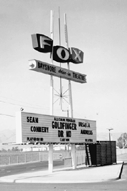
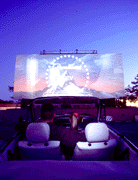
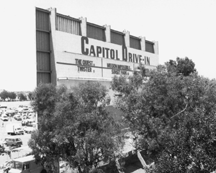
Christopher Gardner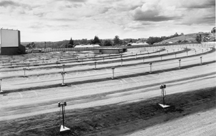
Photo courtesy UC-Santa Cruz Special Collections.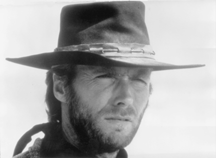
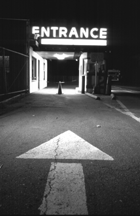

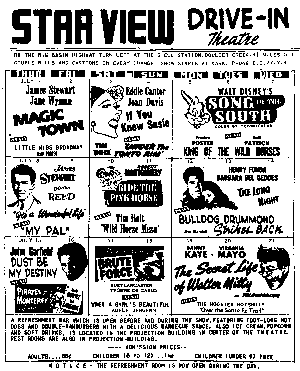
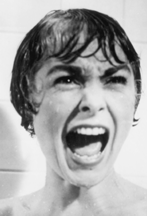
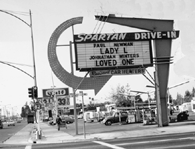
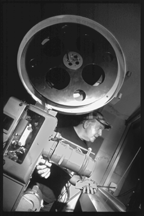
From the June 6-12, 1996 issue of Metro
Copyright © 1996 Metro Publishing and Virtual Valley, Inc.